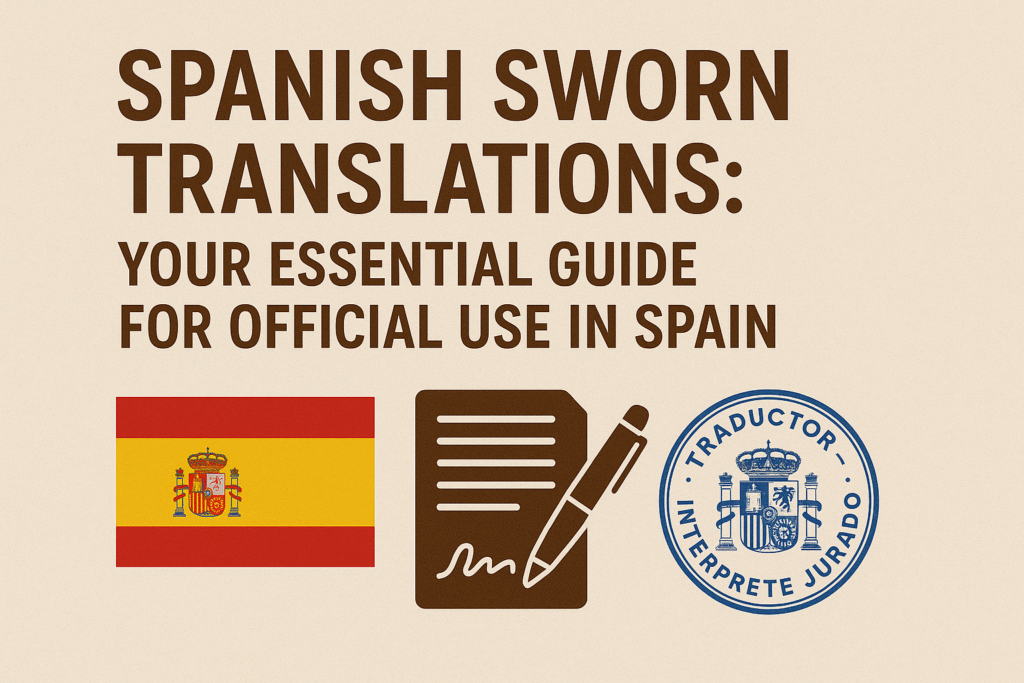Key Facts
- Spanish sworn translations are essential for legal recognition of foreign documents in Spain, ensuring compliance with local regulations.
- A sworn translator is accredited by the Spanish Ministry of Foreign Affairs, providing legal validity to translations.
- Documents typically require an Apostille before translation, certifying their authenticity for international use.
- Common documents needing sworn translations include birth certificates, academic transcripts, and legal contracts.
- Digital signatures for sworn translations offer convenience and cost savings, with legal validity under Spanish law.
For anyone planning to live, work, study, or conduct business in Spain, understanding the role of Spanish sworn translations is absolutely crucial.
These aren’t just any translations; they are a vital link in the chain of document legalization, ensuring your foreign documents are recognized and hold legal weight within Spain.
As experts in the Apostille process for U.S. documents, we partner with Idiomatic USA for our Spanish sworn translation needs.
Below, we’ll shed light on what these translations are, why they’re necessary, and how they seamlessly integrate into the broader document legalization landscape.
What is a Spanish Sworn Translation (Traducción Jurada)?
A Spanish sworn translation, or Traducción Jurada, is an official translation performed by a Sworn Translator-Interpreter (Traductor-Intérprete Jurado).
These highly specialized professionals are officially appointed and accredited by the Spanish Ministry of Foreign Affairs, European Union and Cooperation (MAEC).
What makes a sworn translation unique is its legal validity. Unlike a regular translation, a traducción jurada carries the same legal weight as the original document.
The sworn translator, through their signature, stamp, and certification, attests to the accuracy and fidelity of the translation.
Essentially, they act as a “linguistic notary,” guaranteeing the translated content is a true and complete representation.
Why Are Spanish Sworn Translations Necessary?
If you have a non-Spanish document needing legal effect in Spain, a sworn translation is almost certainly required.
Spanish authorities, from civil registries to universities, demand these certified translations to accept foreign documents as legitimate.
Without one, your documents may be considered null and void, leading to delays and frustration. It’s a mandatory step for compliance with Spanish legal requirements.
Sworn Translations and the Document Legalization Process: The Apostille Connection
A common point of confusion is the Apostille process.
The Apostille, under the Hague Convention of 1961, authenticates a public document for international recognition. Both the U.S. and Spain are signatories.
The general rule: documents typically need to be apostilled prior to being translated by a Spanish sworn translator. The sworn translator translates the entire document, including the Apostille itself.
The Apostille certifies the original document’s authenticity; the sworn translation then certifies the accuracy of the translated text, including the apostille.
However, exceptions exist. The specific order can depend on the consulate or Spanish authority. While Apostille-first is generally recommended, always double-check the exact requirements.
When in doubt, apostilling first is the safest bet.
Common Use Cases for Spanish Sworn Translations
Spanish sworn translations are required for a wide array of official documents:
- For Immigration, Residency, and Citizenship: Birth Certificates, Marriage Certificates, FBI Background Checks / Criminal Record Certificates, Divorce Decrees, Certificates of Single Status, Bank Statements.
- For Academic and Educational Purposes: Academic Transcripts, Diplomas and Degree Certificates, Syllabi or Course Descriptions.
- For Legal and Business Matters: Contracts, Powers of Attorney, Company Registration Documents, Court Judgments, Patents.
- Other common documents: Driver’s Licenses, Medical Certificates, Death Certificates.
The Convenience of Digital Signatures
The Spanish Ministry of Foreign Affairs (MAEC) has embraced digital signatures for sworn translations, a significant client benefit.
Traditionally, sworn translations required a “wet” signature and physical shipping. Now, most are delivered with a qualified electronic signature, meaning:
- Instant Delivery: Receive your translation via email in PDF.
- Convenience: Print and submit to Spanish authorities.
- Cost Savings: No international shipping fees.
- Legal Validity: Under Spanish Law 39/2015, a qualified electronic signature holds the same legal validity as a handwritten signature.
While widely accepted, always confirm any specific submission preferences with the Spanish entity.
Navigating the Spanish administrative landscape requires precision, and Spanish sworn translations are a cornerstone of that precision.
Understanding their role alongside the Apostille ensures a smoother experience with official matters in Spain.
FAQ: Spanish Sworn Translations & Apostilles
Q1: What is the main difference between a regular translation and a Spanish sworn translation?
A1: A regular translation is a linguistic conversion. A Spanish sworn translation (traducción jurada), by an MAEC-accredited translator, includes their official stamp and signature, granting it legal validity for use in Spain.
Q2: Do I always need to apostille my document before getting a sworn translation?
A2: In most cases, yes. The Apostille authenticates the original document, and the sworn translator translates the entire apostilled document. However, always confirm specific requirements with the Spanish consulate or institution.
Q3: Can I get a sworn translation for any document?
A3: Sworn translations are primarily for official documents needing legal effect in Spain, such as birth certificates, academic diplomas, and FBI background checks.
Q4: How can I verify if a translator is a legitimate Spanish sworn translator?
A4: Check the official list maintained by the Spanish Ministry of Foreign Affairs, European Union and Cooperation (MAEC) on their website.
Q5: Are digitally-signed sworn translations accepted in Spain?
A5: Yes, absolutely! Under Spanish Law 39/2015, qualified electronic signatures from MAEC-accredited sworn translators are legally valid and widely accepted.
Q6: How long does it take to get a Spanish sworn translation?
A6: Turnaround time depends on document length and complexity. Digitally-signed translations are often delivered much faster than those requiring physical shipping.


